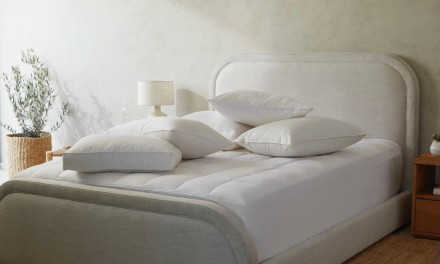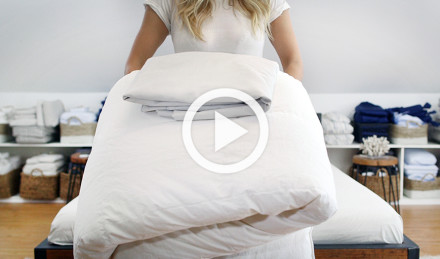Pillows offer comfort, restful sleep and help create a luxurious, pampered feel. But over time, your pillows can absorb hair oils, dust and much more. That’s why maintaining a regular cleaning schedule for your pillows is just as important as it is for any other piece of bedding.
If you’re wondering how to clean a pillow thoroughly and properly, or how often to wash a pillow, you’re not alone. Fortunately, caring for your pillows is easier than you might think.
Can You Wash Pillows?
You can absolutely wash your pillows, and it’s not just a good idea — it’s recommended. Most pillows are designed to be washed either in the washing machine, by hand or by dry cleaning. Your pillows should have a care tag attached with specific washing instructions for successful, thorough cleaning.
How Often Should You Wash Your Pillows?
It’s a good idea to wash your pillow in the washing machine at least every six months, though it never hurts to wash more frequently. If you tend to sweat in your sleep, go to bed with wet hair, share your bed with pets or enjoy a late night snack, wash your pillows more often.
You can help avoid the buildup of allergens and germs in pillows with an increased washing schedule. So — consider washing your pillow if you’ve noticed an uptick in seasonal allergies or if you’ve just gotten over a cold or flu.
How to Wash a Pillow Correctly
In most cases, washing your pillow is as easy as running it through the washing machine on a short, gentle cycle, but you should wash down pillows with cool water and cool drying cycles. Use gentle soaps on down alternative and clean foam pillows by hand. Wash pillows together for a balanced load.
Here are a few best practices to consider, depending on the type of pillow fill you have at home.
How to Wash a Pillow Filled With Down
When it comes to feather or down pillows, the most important factor is avoiding high temperatures. Heat is damaging to natural down feathers, so use cool water. Avoid aggressive agitation that might damage pillows, especially if you have a top-load washing machine with a central agitator.
Usually, a gentle cycle with a short wash duration is best.
If your washing machine tends to be hard on laundry and delicate fabrics, consider visiting a laundromat with front-loading machines when it’s time to wash your pillows.
How to Clean a Pillow Filled With Down Alternative
Down alternative pillows are often a bit less delicate or finicky, but even so, washing them in cool or warm water can protect them from sustaining too much wear and tear. Gentle laundry detergent and the delicate setting also work well for down alternatives and polyester-filled pillows.
How to Wash a Pillow Made of Foam
Foam pillows are the only type of pillow that the washing machine will consistently damage. Hand-wash a pillow made of foam with a small amount of gentle detergent, or dry clean foam pillows to keep them clean. In between washes, vacuum your foam pillows to remove dust and loose debris.
General Best Practices for Washing Pillows
No matter what type of pillow you have, it’s always a good idea to wash more than one pillow at a time so the washing machine is balanced correctly. Out-of-balance machines tend to be more jarring, so keeping your load balanced will help protect your pillows.
Spot cleaning is always an option between more thorough cleanings. If you notice a small sweat, blood or saliva stain, a damp rag with a bit of mild detergent or a pretreat solution will usually remove it. Check out our Stain Guide for more tips on spot cleaning.
Knowing how to clean a pillow includes understanding how to dry it without growing mold or damaging the pillow.
Can You Wash Pillows?
You can absolutely wash your pillows, and it’s not just a good idea — it’s recommended. Most pillows are designed to be washed either in the washing machine, by hand or by dry cleaning. Your pillows should have a care tag attached with specific washing instructions for successful, thorough cleaning.
How Often Should You Wash Your Pillows?
It’s a good idea to wash your pillow in the washing machine at least every six months, though it never hurts to wash more frequently. If you tend to sweat in your sleep, go to bed with wet hair, share your bed with pets or enjoy a late night snack, wash your pillows more often.
You can help avoid the buildup of allergens and germs in pillows with an increased washing schedule. So — consider washing your pillow if you’ve noticed an uptick in seasonal allergies or if you’ve just gotten over a cold or flu.
How to Wash a Pillow Correctly
In most cases, washing your pillow is as easy as running it through the washing machine on a short, gentle cycle, but you should wash down pillows with cool water and cool drying cycles. Use gentle soaps on down alternative and clean foam pillows by hand. Wash pillows together for a balanced load.
Here are a few best practices to consider, depending on the type of pillow fill you have at home.
How to Wash a Pillow Filled With Down
When it comes to feather or down pillows, the most important factor is avoiding high temperatures. Heat is damaging to natural down feathers, so use cool water. Avoid aggressive agitation that might damage pillows, especially if you have a top-load washing machine with a central agitator.
Usually, a gentle cycle with a short wash duration is best.
If your washing machine tends to be hard on laundry and delicate fabrics, consider visiting a laundromat with front-loading machines when it’s time to wash your pillows.
How to Clean a Pillow Filled With Down Alternative
Down alternative pillows are often a bit less delicate or finicky, but even so, washing them in cool or warm water can protect them from sustaining too much wear and tear. Gentle laundry detergent and the delicate setting also work well for down alternatives and polyester-filled pillows.
How to Wash a Pillow Made of Foam
Foam pillows are the only type of pillow that the washing machine will consistently damage. Hand-wash a pillow made of foam with a small amount of gentle detergent, or dry clean foam pillows to keep them clean. In between washes, vacuum your foam pillows to remove dust and loose debris.
General Best Practices for Washing Pillows
No matter what type of pillow you have, it’s always a good idea to wash more than one pillow at a time so the washing machine is balanced correctly. Out-of-balance machines tend to be more jarring, so keeping your load balanced will help protect your pillows.
Spot cleaning is always an option between more thorough cleanings. If you notice a small sweat, blood or saliva stain, a damp rag with a bit of mild detergent or a pretreat solution will usually remove it. Check out our Stain Guide for more tips on spot cleaning.
Knowing how to clean a pillow includes understanding how to dry it without growing mold or damaging the pillow.
How to Dry Pillows Safely
How you dry your pillows depends on how much time you have. You can air-dry your pillows if you have plenty of time and a dry, warm environment that will ensure they dry completely. Otherwise, it’s best to dry most pillows in the clothes dryer, on the low setting to best protect them.
Air Drying Pillows
You can air dry any type of pillow from down fill to memory foam. When air drying, airflow is key. Place pillows on a laundry drying rack or hang them from a line, taking care to rotate them regularly to avoid stretching or clumping.
Make sure your pillows are completely dry, especially if you have high-density models. Moist pillows are more prone to mildewing, and the last thing you want is to lay your head on a pillow that’s still a bit wet in the middle!
Using the Dryer
If you need your pillows to dry a bit more quickly, you can put them in the dryer on the tumble-dry low setting. Adding a couple of Wool Dryer Balls to the dryer will help them retain their shape and avoid compression.
You may need to run your pillows through the dryer a few times before they are completely dry. In between cycles, Take them out and fluff them so they dry evenly.
How to Dry Pillows Safely
How you dry your pillows depends on how much time you have. You can air-dry your pillows if you have plenty of time and a dry, warm environment that will ensure they dry completely. Otherwise, it’s best to dry most pillows in the clothes dryer, on the low setting to best protect them.
Air Drying Pillows
You can air dry any type of pillow from down fill to memory foam. When air drying, airflow is key. Place pillows on a laundry drying rack or hang them from a line, taking care to rotate them regularly to avoid stretching or clumping.
Make sure your pillows are completely dry, especially if you have high-density models. Moist pillows are more prone to mildewing, and the last thing you want is to lay your head on a pillow that’s still a bit wet in the middle!
Using the Dryer
If you need your pillows to dry a bit more quickly, you can put them in the dryer on the tumble-dry low setting. Adding a couple of Wool Dryer Balls to the dryer will help them retain their shape and avoid compression.
You may need to run your pillows through the dryer a few times before they are completely dry. In between cycles, Take them out and fluff them so they dry evenly.
Proper Care for Pillows
Regular routine maintenance for your pillows is always your best choice. As long as you properly care for them on a daily or weekly basis, you won’t need to machine wash a pillow more than two to four times each year.
Fluff and Refresh Your Pillows
Fluffing goes hand in hand with knowing how to wash a pillow. About once per week or every time you change your sheets, shake out your pillows and fluff them up. Fluffing keeps the fill evenly distributed throughout, and loosens any debris on the outside before it can work its way into the middle.
You can also put your pillows in the dryer for a no-heat tumble cycle or hang them on the clothesline to freshen them.
Extra Protection for Your Pillows
If you’re a hot sleeper or you usually wash your hair before bed, consider investing in a pillow liner or a second pillowcase to protect your clean pillows from increased moisture and staining.
Proper Care for Pillows
Regular routine maintenance for your pillows is always your best choice. As long as you properly care for them on a daily or weekly basis, you won’t need to machine wash a pillow more than two to four times each year.
Fluff and Refresh Your Pillows
Fluffing goes hand in hand with knowing how to wash a pillow. About once per week or every time you change your sheets, shake out your pillows and fluff them up. Fluffing keeps the fill evenly distributed throughout, and loosens any debris on the outside before it can work its way into the middle.
You can also put your pillows in the dryer for a no-heat tumble cycle or hang them on the clothesline to freshen them.
Extra Protection for Your Pillows
If you’re a hot sleeper or you usually wash your hair before bed, consider investing in a pillow liner or a second pillowcase to protect your clean pillows from increased moisture and staining.
How Often to Replace Pillows for Comfort and Health
Knowing when to replace pillows comes down to comfort, support and cleanliness. Not all pillows are the same, and your needs for shape or firmness may change over time. If you notice that your pillow isn’t helping you achieve a restful sleep, it may be time to switch things up with a new set.
As time goes by, the materials in our pillows compress and lose their supportive shape. Unsupportive pillows can stress the muscles, tendons and nerves in the neck and shoulders, so it’s important to replace your pillow if it gets too compressed or floppy.
Selecting Long-Lasting Replacement Pillows
When it's time to replace the pillows on your bed, consider investing in a high-quality replacement made with supportive, safe and eco-friendly materials. By selecting a well-made pillow, you can improve your sleep quality while you ensure that your pillow will last longer.
Whether you’re a side sleeper or a back sleeper, prefer a down pillow or a down-alternative pillow or like to snuggle up to a body pillow at night, you’ll find a diverse selection of pillows to suit any sleep style, density and other sleep preferences at Parachute.
Sleep Soundly and Safely With Cleaner Pillows
With proper care, a consistent washing schedule and high-quality pillows, it’s easy to set yourself up for restful sleep. No matter what type of pillow you use, make cleanliness and health a priority. When you’re ready to replace your pillows, select light, lofty and supportive pillows by Parachute for better sleep and a more harmonious home.
How Often to Replace Pillows for Comfort and Health
Knowing when to replace pillows comes down to comfort, support and cleanliness. Not all pillows are the same, and your needs for shape or firmness may change over time. If you notice that your pillow isn’t helping you achieve a restful sleep, it may be time to switch things up with a new set.
As time goes by, the materials in our pillows compress and lose their supportive shape. Unsupportive pillows can stress the muscles, tendons and nerves in the neck and shoulders, so it’s important to replace your pillow if it gets too compressed or floppy.
Selecting Long-Lasting Replacement Pillows
When it's time to replace the pillows on your bed, consider investing in a high-quality replacement made with supportive, safe and eco-friendly materials. By selecting a well-made pillow, you can improve your sleep quality while you ensure that your pillow will last longer.
Whether you’re a side sleeper or a back sleeper, prefer a down pillow or a down-alternative pillow or like to snuggle up to a body pillow at night, you’ll find a diverse selection of pillows to suit any sleep style, density and other sleep preferences at Parachute.
Sleep Soundly and Safely With Cleaner Pillows
With proper care, a consistent washing schedule and high-quality pillows, it’s easy to set yourself up for restful sleep. No matter what type of pillow you use, make cleanliness and health a priority. When you’re ready to replace your pillows, select light, lofty and supportive pillows by Parachute for better sleep and a more harmonious home.








